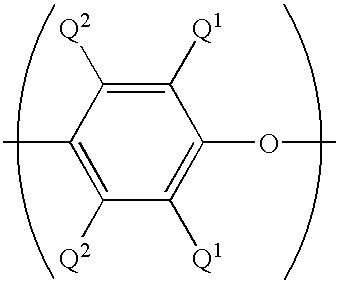Moldable poly(arylene ether) thermosetting compositions, methods, and articles
- Summary
- Abstract
- Description
- Claims
- Application Information
AI Technical Summary
Benefits of technology
Problems solved by technology
Method used
Image
Examples
examples 1 and 2
[0072] These examples illustrate preparation of compositions comprising a directly isolated poly(arylene ether) resin. Using proportions specified in the Table, epoxy resin EPON.RTM. 828 and plasticizer resorcinol diphosphate were charged into a flask with stirring. The solution was heated and as the temperature reached about 100.degree. C., polyvinyl butyral (poly(vinyl butyral-co-polyvinyl alcohol-co-polyvinyl acetate) having a polyvinyl butyral content of about 88%, obtained as BUTVAR.RTM. B76 from Solutia) was added; the polyvinyl butyral appeared to dissolve completely as the temperature reached about 150.degree. C. As the temperature reached about 160.degree. C., poly(arylene ether) (directly isolated poly(2,6-dimethylphenyl ether), intrinsic viscosity 0.30 dL / g at 25.degree. C. in chloroform; prepared and isolated according to known techniques for oxidative coupling of 2,6-xylenol; see, for example, U.S. Pat. No. 3,306,875 to Hay) was added. As the temperature reached about 2...
example 3
[0073] This example illustrates preparation of a composition using a solid concentrate of poly(arylene ether) and epoxy resin. Fifty weight parts each of EPON.RTM. 828 and poly (arylene ether) (directly isolated poly(2,6-dimethylphenyl ether) having an intrinsic viscosity of 0.40 dL / g as measured in chloroform at 25.degree. C.; obtained as NORYL.RTM. 640-111 from GE Plastics) and 0.5 parts Bisphenol A from Shell Chemical were charged into a vessel containing toluene to form an approximately 40% solids solution. After stirring and heating at 95.degree. C. for one hour, the poly(arylene ether) was completely dissolved, and 0.677 parts 75% benzoyl peroxide stabilized with water (obtained from Catalyst Systems, Inc.) was added to redistribute the poly(phenylene ether) and lower its intrinsic viscosity to 0.30 dL / g. The toluene was removed to yield a solid concentrate consisting of approximately equal weight parts of polyepoxide and redistributed poly(phenylene ether) having an intrinsic...
example 4
[0074] The procedure of Example 4 was followed, except that the powdered concentrated was prepared and used as a 67:33 weight / weight ratio of redistributed poly(arylene ether) and polyepoxide. Results are presented in the Table. [t1]
1 TABLE C. Ex. 1 Ex. 1 Ex. 2 Ex. 3 Ex. 4 COMPOSITION PPE (0.301 V) -- 9.5 15 -- -- PPE as a 50 50 -- -- -- 15 --PPE / Epoxy composition PPE as a 67:33 -- -- -- -- 15 PPE / Epoxy composition EPON .RTM. 828 100 85 78 65 72 EPON .RTM. 828 a 50 50 -- -- -- 15 --PPE / Epoxy composition EPON .RTM. 828 as a 67:33 -- -- -- -- 8 PPE / Epoxy composition Polyvinyl Butyral -- 5.5 5 5 5 Resorcinol Diphosphate -- 11 13 -- 7 (pbw per 100 pbw PPE) Methylene-bis-diethyl 46 41 46 46 46 aniline (pbw per 100 pbw EPON .RTM. 828) PROPERTIES Molded part thickness 2.688 2.976 3.717 3.136 2.611 (mm) T.sub.g (.degree. C.) 137 / 156 145 / 207 142 / 187 141 / 207 145 / 203 Z-axis expansion, 30- 3.05 3.46 3.52 3.18 3.50 260.degree. C., neat resin bar (%) K.sub.1C fracture toughness 0.75 -- 0.97 1.10 ...
PUM
| Property | Measurement | Unit |
|---|---|---|
| Fraction | aaaaa | aaaaa |
| Percent by mass | aaaaa | aaaaa |
| Percent by mass | aaaaa | aaaaa |
Abstract
Description
Claims
Application Information
 Login to View More
Login to View More - R&D
- Intellectual Property
- Life Sciences
- Materials
- Tech Scout
- Unparalleled Data Quality
- Higher Quality Content
- 60% Fewer Hallucinations
Browse by: Latest US Patents, China's latest patents, Technical Efficacy Thesaurus, Application Domain, Technology Topic, Popular Technical Reports.
© 2025 PatSnap. All rights reserved.Legal|Privacy policy|Modern Slavery Act Transparency Statement|Sitemap|About US| Contact US: help@patsnap.com



